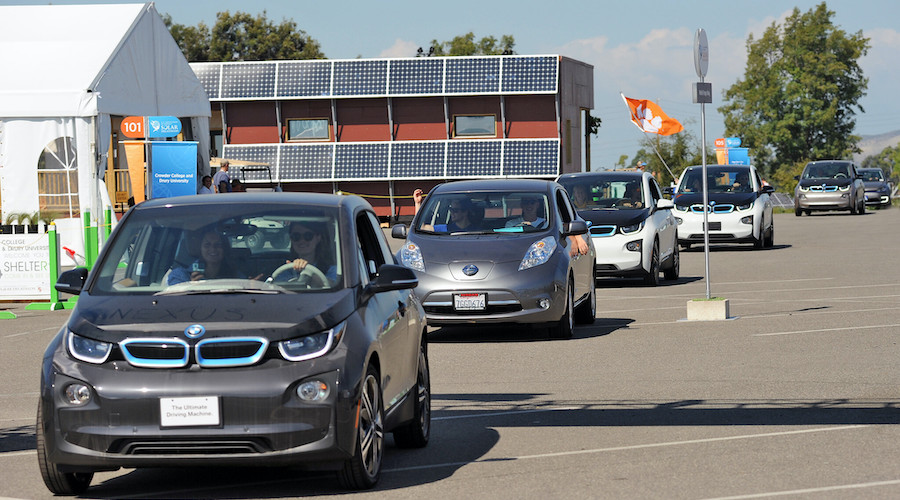Global S&T Development Trend Analysis Platform of Resources and Environment
| EV industry moving in right direction to close gap with internal combustion engines – report | |
| admin | |
| 2022-01-12 | |
| 发布年 | 2022 |
| 语种 | 英语 |
| 国家 | 国际 |
| 领域 | 地球科学 |
| 正文(英文) |  Electric cars on parade. (Image by Dept of Energy Solar Decathlon, Flickr).
Although there is still a way to go for electric vehicles to close the performance, safety, and cost gap with internal combustion engines, a recent report by IDTechEx says some specific moves by the EV industry are steps in the right direction. According to the report’s author, Luke Gear, one major positive trend is the increased electrification of a variety of sectors, not just automotive. “A decade ago, IDTechEx’s 2011 report ‘bullishly’ predicted 1.5 million battery-electric car sales by 2021 – this turned out to be an underestimate by over half, as China, the US, and Europe all grew their markets last year,” Gear points out. “The sheer volumes and successes of electric vehicles in the automotive market are driving down costs, creating opportunities for many other mobility sectors.” Boats and ships are among those experiencing an electrification boom, with electric ferry deliveries having grown to ~80MWh yearly as battery pack costs fell below $600 per kWh, energy densities improved and thermal management innovations vastly increased safety. In the author’s view, similar drivers are pushing forward investment into electric air-taxis, as American Airlines, Virgin Atlantic, United Airlines, UPS and Avolon have all placed pre-orders. “Electrification is not so much unstoppable as inevitable and will continue to play a dominant role in the decarbonization of mobility,” the report reads. When it comes to batteries, the market analyst forecasts that lithium-based batteries will continue to be the great enabler for electrification, particularly if the industry expands its efforts to increase the sustainability of raw materials and supply chains whilst ensuring there is still enough supply to meet the growing demand. “Later in the decade, a move beyond li-ion towards the holy grail of solid-state and lithium-metal batteries is critical for a step-change in safety and performance, and to open the door to new applications such as electric long-haul aircraft,” the report states. Motors and powertrainsFor Gear, another move that is expected to gain traction in the coming years is the utilization of magnet-free and even copper-free motor solutions as automakers start adopting several technologies to balance performance, sustainability, market demand, and cost. The expert explains that due to their high performance and superior efficiency, permanent magnet motors are the default technology for traction applications and their market has naturally grown with the runaway success of electric cars. However, magnets make end-of-life recycling difficult, and raise concerns regarding price volatility and sustainable mining practices, with most material mined and sourced in China. “Long-term reliance solely on permanent magnet machines is looking increasingly unsustainable, with warning signs starting to show in high neodymium prices – the primary ingredient of rare earth magnets.” On a similar note, it is likely that more and more automakers will switch to wide bandgap power electronics, especially silicon carbide MOSFET devices. IDTechEx data predict roughly half the electric car market switching to these efficient devices by 2030, thus enabling efficient high voltage powertrains. “Early in 2022, Mercedes showcased the Vision EQXX concept capable of 1000km. While there is a lot of technology behind this concept, including solar bodywork, design (drag factor), silicon anode batteries, and axial flux motors, a key enabler is the 900V platform – something only practical with silicon carbide,” the dossier states. Key safety featuresFinally, increased attention to safety features is expected to be key in the years to come, particularly when it comes to the thermal management of electric motors and power electronics. “Permanent magnet motors require a specific operating temperature to avoid damage. Additionally, allowing the copper coils in a motor to get too hot can lead to reduced efficiency or damage to the winding insulation,” Gear writes. “The silicon carbide transition in power electronics is also presenting a host of package-level thermal challenges to deal with the increased junction temperatures including wire bonding, die-attach, and substrate technologies.” In the battery realm, the analyst highlights the fact that battery chemistry is evolving with higher nickel cathodes being adopted, LFP batteries making a resurgence and more attention being paid to solid-state batteries. “These changes have a profound impact on the requirements around thermal management and materials in EV batteries,” Gear points out. “Outside the cell, we see OEMs transitioning towards cell-to-pack designs with announcements from Tesla, Stellantis, BYD, VW and more. This fundamental change in battery pack structure leads to changes in how thermal strategies and materials are incorporated, including thermal interface materials, coolant channels and fire protection.”
|
| URL | 查看原文 |
| 来源平台 | Minging.com |
| 文献类型 | 新闻 |
| 条目标识符 | http://119.78.100.173/C666/handle/2XK7JSWQ/343514 |
| 专题 | 地球科学 |
| 推荐引用方式 GB/T 7714 | admin. EV industry moving in right direction to close gap with internal combustion engines – report. 2022. |
| 条目包含的文件 | 条目无相关文件。 | |||||
| 个性服务 |
| 推荐该条目 |
| 保存到收藏夹 |
| 查看访问统计 |
| 导出为Endnote文件 |
| 谷歌学术 |
| 谷歌学术中相似的文章 |
| [admin]的文章 |
| 百度学术 |
| 百度学术中相似的文章 |
| [admin]的文章 |
| 必应学术 |
| 必应学术中相似的文章 |
| [admin]的文章 |
| 相关权益政策 |
| 暂无数据 |
| 收藏/分享 |
除非特别说明,本系统中所有内容都受版权保护,并保留所有权利。
修改评论